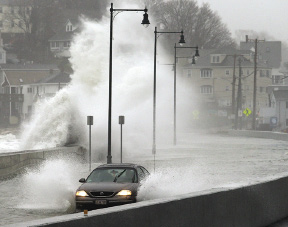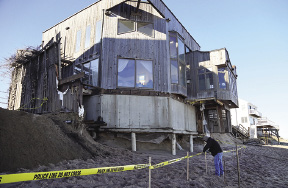There is perhaps nothing more fundamental to the fabric of New England's character than its relationship with water; be it the ocean or its abundant lakes and rivers. Synonymous with New England waterscapes are its numerous panoramic properties and breathtaking homes. So it comes as no surprise that the recent roll-out of newly proposed federal flood zone maps - maps that could stymie the rights of owners to develop their properties or dramatically increase insurance costs - would trouble the waters for New England property owners.
In the coming weeks and months, the Federal Emergency Management Agency (FEMA) will finalize proposed flood zone maps for coastal communities across New England. The new maps will shift flood zones further inland and upland, encompassing more homes and businesses in high-risk zones. Almost as troubling as the proposed maps, are the recently escalating rates for federal flood insurance. The consequences of the expanded maps and the increased rates could be problematic for the many New England property owners near lakes, rivers or the ocean.
How does flood insurance work?
For residents or businesses located in areas historically prone to flooding, obtaining flood insurance can be challenging and sometimes, cost-prohibitive. Making matters more complicated, flood insurance is generally required by mortgage lenders to finance real estate situated in designated flood zone areas. To help alleviate many of these issues, the United States Congress created the National Flood Insurance Program (NFIP) in 1968. However, to participate in the program, communities must agree to develop management plans that reduce long-term flooding risk, such as the development of and adherence to floodplain maps.
What are the effects of
the proposed maps?
In response to the rash of more frequent and damaging storms like Hurricane Katrina and Superstorm Sandy, FEMA has undertaken an effort to update floodplain maps. FEMA's maps illustrate regions that are prone to flooding by classifying them into various types of zones. Property owners in zones deemed to have a higher risk of flooding pay higher insurance premiums.
Many New England real estate owners are frustrated by the newly proposed floodplain maps because they greatly expand the coverage of high-risk zones. A property owner with a mortgage that is currently in a low-risk zone may now be forced to purchase flood insurance for the first time. A property owner currently in a low to moderate-risk zone may now find himself in a high-risk zone forced to pay additional thousands of dollars each year for insurance. Moreover, the enlargement of zones may also inhibit a property owner's ability to expand existing structures or force structures to be elevated above proposed base flood evaluations.
What options do property
owners have after the
proposed maps are released?
After FEMA's proposed maps are released to a municipality or "community," it is critical for property owners to remember two things: first, the maps are not final, and second, the clock begins ticking almost immediately. The community must notify property owners of the proposed maps in a local newspaper and following the second notification, a 90-day appeal period starts.
Property owners who may be impacted by the proposed maps should first inquire into whether the community plans to hire an engineering consultant and an attorney to help review and appeal the maps. If the community does not intend to appeal, a concerned property owner should promptly consult an engineer and attorney to review their options. Even if a community plans to file an appeal, individual property owners should not rest easy. It is possible the appeal might produce favorable mapping results for the community, but not for a property owner's parcel. Hiring an engineering consultant and attorney will help ensure individual property rights are protected.
In many cases, the community may be reluctant to initiate the appeal process unless local landowners voice concerns with the proposed maps. Property owners or their representatives should encourage the community to collect individual appeals on behalf of its residents and submit a collective appeals package to FEMA. Pursuant to federal regulations, the community must provide detailed evidence, "that the elevations proposed by FEMA are scientifically or technically inaccurate." The burden of gathering such scientific evidence often falls on the property owners.
Should I appeal the
proposed maps for my area?
In some communities, FEMA has received criticism for its proposed flood maps. Individuals and communities appealing proposed maps contend that FEMA's limited budget and tight timelines do not allow for the most accurate or sophisticated mapping processes. Specifically in New England, FEMA's methodology has been challenged for not accounting for the sheltered nature of rocky and elevated coastlines. Because the use of more sophisticated methods can generate significant differences in flood zone elevations, New England communities have a strong incentive to ensure FEMA's proposed maps are accurate.
What happens once a
community appeals a map?
If a community files an appeal within the 90-day window, it will enter into a period of negotiation with FEMA. During that period, FEMA and the community (often with the property owner taking the lead) will compare expert data in an attempt to reach a position both parties find agreeable. If a middle ground cannot be reached, the matter may then be resolved through either an Administrative Hearing or through a process recently initiated by the U.S. Congress called the Scientific Resolution Panel (SRP).
Administrative hearings are conducted by a three-member panel of non-FEMA employees, with the Federal Insurance Administrator's chief council representing FEMA. The scope of the review is limited to the data presented during the 90-day appeal and the community retains the burden of proving FEMA's initial determination is not scientifically or technically sound. Within 45 days of the hearing, the board will deliver its written opinion to the administrator for use in reaching its final determination.
A community may also elect to utilize the SRP for its review. The SRP is an impartial body of technical experts tasked with reviewing the data from both the community and FEMA. To initiate an SRP review, the community must submit a written request to FEMA. Before the SRP process may begin, 60 days of "collaborative consultation" or negotiations (but no more than 120) must take place between FEMA and the community without reaching a resolution. Additionally, if FEMA has already issued a Resolution Letter, the community has 30 days from the date of the letter to submit an application requesting the SRP process. After the SRP has reviewed the relevant submissions, the Panel then issues a written decision to the FEMA administrator for guidance in reaching a final determination.
What if FEMA issues an
unfavorable final determination?
The SRP process does not change the appeal options for a community, and the SRP decision is not subject to judicial review except in the case of grave error. A community (or property owner) that does not agree with the Administrator's final determination may appeal the decision to the United States District Court within 60 days of the date of the final determination. Additionally, after the 90-day window has closed and the proposed maps have become final, an individual property owner may still possess options for appeal (such as an application for a LOMR or LOMA); however, property owners should be aware that appealing during the 90-day window may be more likely to yield the desired results than waiting until after proposed maps have been finalized.
Helpful Resources:
* Current FEMA Issued Flood Maps, available at https://msc.fema.gov/webapp/wcs/stores/servlet/FemaWelcomeView?storeId=10001&catalogId=10001&langId=-1&userType=G
* FEMA National Flood Insurance Program Flood Map Update Schedule, available at http://www.floodsmart.gov/floodsmart/pages/flooding_flood_risks/map_update_schedule.jsp
* FEMA Frequently Asked Questions, available at https://faq.fema.gov/
* FEMA Map Information eXchange (FMIX) Hotline to speak to a FEMA Map Specialist: 1-877-FEMA MAP (1-877-336-2627).
* FEMA Administrative Hearing Procedures, available at 44 CFR§ 68, http://www.gpo.gov/fdsys/pkg/CFR-2010-title44-vol1/pdf/CFR-2010-title44-vol1-part68.pdf
* FEMA Scientific Resolution Panels, available at http://www.fema.gov/media-library-data/20130726-1852-25045-6976/srp_fact_sheet_08302012.pdf
* One-Step Flood Risk Profile, available at http://www.floodsmart.gov/floodsmart
Charles Katz-Leavy is an attorney at Verrill Dana LLP, which has offices in Maine, Mass., Conn. and Washington, D.C. Mathew Todaro assisted with this article.











